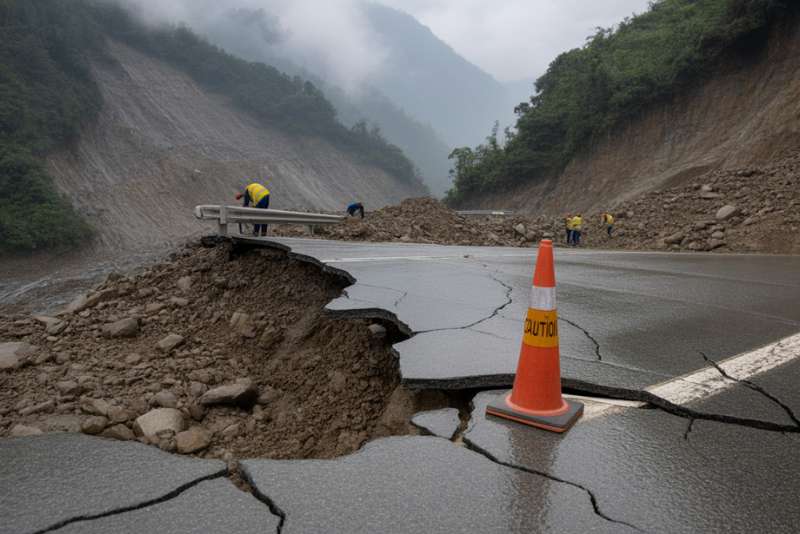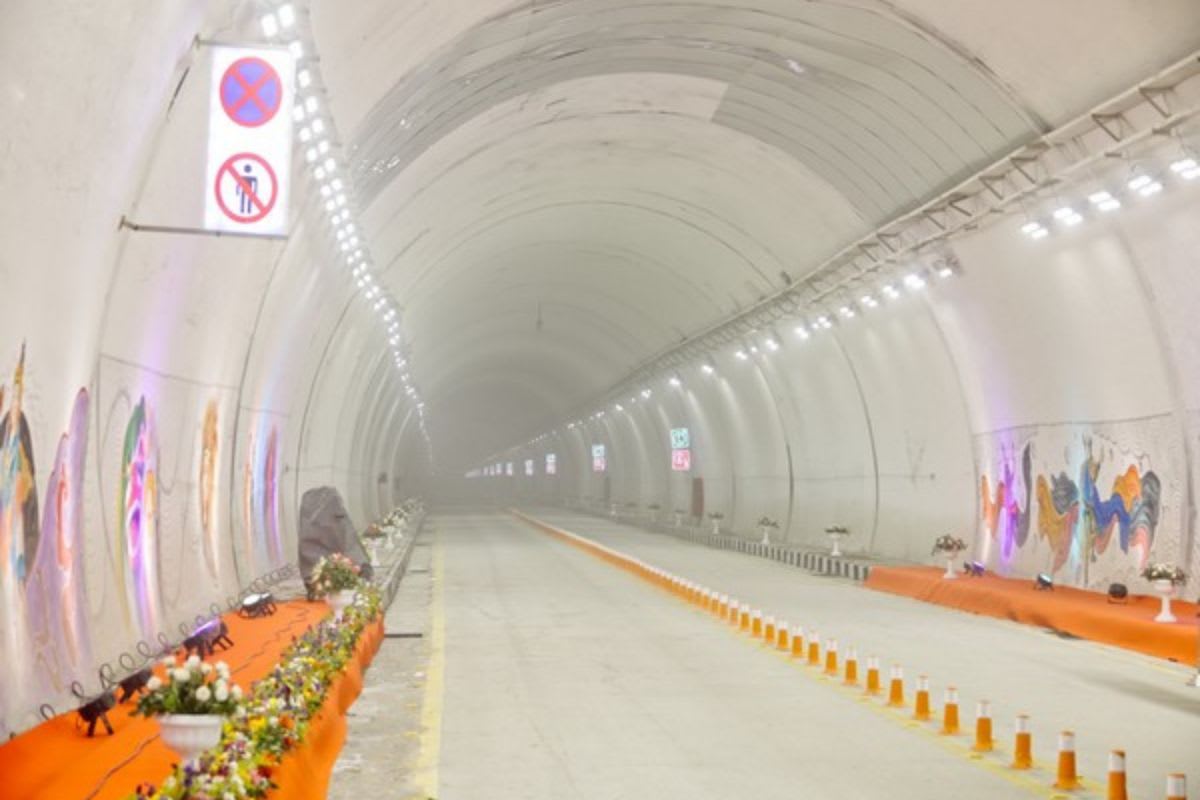
Gangtok: The Himalayan state of Sikkim has witnessed a dramatic week between August 1-6, 2025, marked by significant infrastructure challenges, remarkable conservation achievements, and important cultural announcements that collectively paint a portrait of resilience amid adversity.
Infrastructure Under Siege: Landslides Paralyze Transportation Networks
The state’s critical transportation arteries faced unprecedented disruption during this period, beginning with a landslide at Tarkhola on August 2 that affected National Highway-10, the vital lifeline connecting Sikkim to the Indian plains. The situation escalated dramatically when authorities announced a complete closure of the 30-kilometer stretch between Sevoke and Chitrey from 8 PM on August 3 to 6 PM on August 6.

Timeline of Major News Events in Sikkim (August 1-6, 2025)
The highway closure, enforced by the National Highways and Infrastructure Development Corporation Limited (NHIDCL) under Section 33 of the National Highway (Land and Traffic) Act, 2002, was prompted by dangerous cracks that emerged following multiple landslides triggered by heavy monsoon rainfall. The decision affected not just local commuters but also tourists and essential goods transportation to the landlocked state.
Railway Infrastructure Severely Impacted
The crisis deepened when the ambitious Sevoke-Rangpo railway project, designed to connect Sikkim to India’s rail network, suffered significant damage. On August 5, a landslide at Rabi Jhora destroyed a section of the slope protection wall near Tunnel No. 7, raising concerns about the stability of construction zones along the alignment. The incident occurred despite precautionary measures that had already removed workers and machinery from the vulnerable site ahead of heavy rainfall.

Northeast Frontier Railways confirmed that while no casualties occurred, the landslide struck approximately 30 meters from the tunnel location, compromising the protective infrastructure essential for safe construction operations. This railway line, featuring 14 tunnels with a combined length of 38.64 kilometers, represents a crucial infrastructure project that will significantly improve connectivity to the Himalayan state once completed.
The closure forced travelers to use three alternative routes: Siliguri-Jorbungalow-Teesta Bazaar-Rangpo-Gangtok, Siliguri-Sevoke-Damdim-Gorubathan-Lava-Alagarah-Rangpo-Gangtok, and the recently constructed National Highway 717A via Bagrakote-Lava-Alagarah. However, even the new NH-717A faced disruption due to a separate landslide near Katarey.
Conservation Triumph: Red Pandas Signal Hope for Biodiversity
Amid the infrastructure challenges, Sikkim celebrated a remarkable conservation achievement with the birth of two red panda cubs at the Himalayan Zoological Park in Bulbuley near Gangtok. The cubs, born on June 15 to parents Lucky (II) and Mirak, represent the first successful births in seven years, marking a significant milestone for the park’s Red Panda Conservation Breeding Program.

The birth becomes particularly meaningful considering the program’s challenging history, which included two devastating outbreaks of Canine Distemper that nearly decimated the captive red panda population. The Himalayan Zoological Park, which initiated its Conservation Breeding Programme in 1997, maintains all red pandas born under the program through national and international studbooks to ensure healthy genetic variability and global breeding cooperation.
The successful breeding demonstrates remarkable parental behavior, with both Lucky (II) and Mirak observed participating in nest-building activities—a rare instance of male involvement in the species. The cubs will remain with their parents away from public viewing until they mature sufficiently, reaching full size by 12 months and sexual maturity by 18 months.
Cultural Renaissance: Cinema and Social Recognition
Sikkim’s cultural landscape received international recognition when filmmaker Tribeny Rai’s debut Nepali feature film “Shape of Momo” (Chhora Jastai) was officially selected for the prestigious San Sebastián International Film Festival 2025 in Spain. The film will be showcased in the competitive ‘New Directors’ category, representing a historic achievement for Sikkim and Indian Nepali-language cinema.
The India-South Korea co-production follows the story of Bishnu, who returns to her Himalayan village after quitting her job, only to face mounting family pressures and societal expectations. Rai, born in Sikkim in 1991, hails from the state’s border region with Nepal, providing authentic cultural context to the narrative.
Social Innovation: Honoring Intergenerational Care
The Sikkim government introduced a groundbreaking social initiative on August 6 with the announcement of the “Shravan Kumar Award,” recognizing individuals who demonstrate exceptional devotion to their elderly parents. Named after the revered mythical character from the Ramayana who epitomized filial piety, this initiative reflects the state’s commitment to traditional family values.
The award, first announced by Chief Minister Prem Singh Tamang on August 15, 2023, will be presented annually on Independence Day. Recipients from every gram panchayat across Sikkim will receive a substantial cash prize of Rs 1 lakh, with the program particularly aimed at supporting economically disadvantaged families who exemplify profound devotion to their parents.
The initiative comes as part of broader social welfare measures, including the upcoming “Aama Samman Diwas” (Mother’s Honor Day) scheduled for August 10 at Rangpo Playground. This celebration will mark the first-ever statewide public event in India dedicated entirely to honoring mothers, with over 32,000 mothers expected to receive financial aid through the Sikkim Aama Sasaktikaran Yojana.
Political Realignment: Opposition Weakens as Ruling Party Gains
The political landscape witnessed significant movement when Hemraj Adhikari, founder member and General Secretary (Publicity) of the Citizen Action Party (CAP), officially joined the ruling Sikkim Krantikari Morcha (SKM) on August 4. Chief Minister Prem Singh Tamang welcomed Adhikari’s decision as “a strong affirmation of shared vision for progressive, inclusive, and people-centric governance”.
Adhikari’s political transition coincided with his literary recognition, as he received the prestigious “Hemlata Smriti Laghu Katha Samman–2082” award in Chitawan, Nepal, highlighting his contributions to Nepali literature and cultural preservation. The move represents a significant blow to the opposition CAP while strengthening the ruling party’s grassroots presence.
Monsoon Challenges and Emergency Response
The infrastructure crisis occurred against the backdrop of intense monsoon activity that has characterized the 2025 season across the northeastern Himalayas. Heavy rainfall triggered more than 90 landslides across the region in the preceding week, causing the Teesta and Jaldhaka rivers to swell and overflow into low-lying areas.
Emergency protocols activated by authorities demonstrate the state’s preparedness for natural disasters, with the Border Roads Organisation maintaining Sikkim’s road network and coordinating with NHIDCL for rapid response. The India Meteorological Department issued warnings for very heavy rain with isolated extremely heavy downpours in sub-Himalayan districts until August 5.
Economic Implications and Recovery Prospects
The transportation disruptions carry significant economic implications for Sikkim’s tourism-dependent economy, particularly during the peak monsoon travel season. The state, which has invested heavily in tourism infrastructure and promotion, faced immediate challenges in maintaining visitor accessibility during the highway closures.
However, the successful red panda breeding program and international film festival recognition provide positive economic indicators for Sikkim’s growing reputation as a destination for eco-tourism and cultural tourism. The state’s commitment to organic agriculture and sustainable development continues to attract environmentally conscious visitors despite temporary infrastructure challenges.
The Shravan Kumar Award initiative, alongside the Aama Samman Diwas celebration, positions Sikkim as a pioneer in social innovation, potentially attracting national attention to the state’s progressive governance model. These cultural and social initiatives demonstrate the government’s ability to advance meaningful programs despite facing significant infrastructure challenges.
The period from August 1-6, 2025, will likely be remembered as a defining week that showcased Sikkim’s resilience in the face of natural disasters while simultaneously celebrating conservation successes, cultural achievements, and social innovation. The state’s ability to maintain focus on long-term development goals while managing immediate crisis response reflects the maturity of its governance systems and the dedication of its people to building a sustainable future.
Also Read: CAP Sikkim Calls for Release of CCTV Footage After July 17 Gangtok Assault
Gangtokian Web Team, 06/08/2025

















































